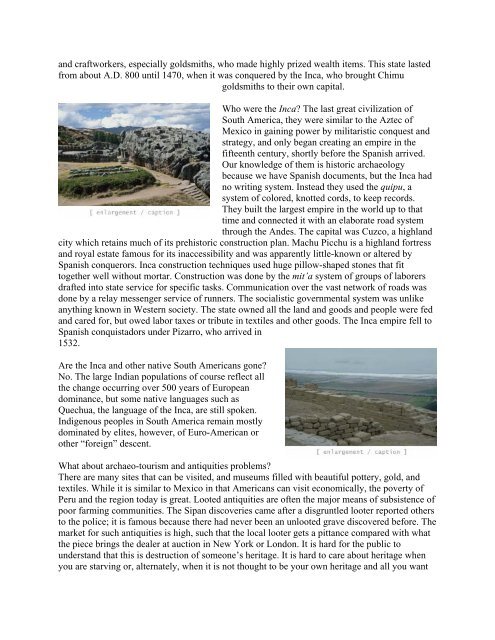INTRODUCTION TO ARCHAEOLOGY Nancy White - Touro Institute
INTRODUCTION TO ARCHAEOLOGY Nancy White - Touro Institute
INTRODUCTION TO ARCHAEOLOGY Nancy White - Touro Institute
You also want an ePaper? Increase the reach of your titles
YUMPU automatically turns print PDFs into web optimized ePapers that Google loves.
and craftworkers, especially goldsmiths, who made highly prized wealth items. This state lasted<br />
from about A.D. 800 until 1470, when it was conquered by the Inca, who brought Chimu<br />
goldsmiths to their own capital.<br />
Who were the Inca? The last great civilization of<br />
South America, they were similar to the Aztec of<br />
Mexico in gaining power by militaristic conquest and<br />
strategy, and only began creating an empire in the<br />
fifteenth century, shortly before the Spanish arrived.<br />
Our knowledge of them is historic archaeology<br />
because we have Spanish documents, but the Inca had<br />
no writing system. Instead they used the quipu, a<br />
system of colored, knotted cords, to keep records.<br />
They built the largest empire in the world up to that<br />
time and connected it with an elaborate road system<br />
through the Andes. The capital was Cuzco, a highland<br />
city which retains much of its prehistoric construction plan. Machu Picchu is a highland fortress<br />
and royal estate famous for its inaccessibility and was apparently little-known or altered by<br />
Spanish conquerors. Inca construction techniques used huge pillow-shaped stones that fit<br />
together well without mortar. Construction was done by the mit’a system of groups of laborers<br />
drafted into state service for specific tasks. Communication over the vast network of roads was<br />
done by a relay messenger service of runners. The socialistic governmental system was unlike<br />
anything known in Western society. The state owned all the land and goods and people were fed<br />
and cared for, but owed labor taxes or tribute in textiles and other goods. The Inca empire fell to<br />
Spanish conquistadors under Pizarro, who arrived in<br />
1532.<br />
Are the Inca and other native South Americans gone?<br />
No. The large Indian populations of course reflect all<br />
the change occurring over 500 years of European<br />
dominance, but some native languages such as<br />
Quechua, the language of the Inca, are still spoken.<br />
Indigenous peoples in South America remain mostly<br />
dominated by elites, however, of Euro-American or<br />
other “foreign” descent.<br />
What about archaeo-tourism and antiquities problems?<br />
There are many sites that can be visited, and museums filled with beautiful pottery, gold, and<br />
textiles. While it is similar to Mexico in that Americans can visit economically, the poverty of<br />
Peru and the region today is great. Looted antiquities are often the major means of subsistence of<br />
poor farming communities. The Sipan discoveries came after a disgruntled looter reported others<br />
to the police; it is famous because there had never been an unlooted grave discovered before. The<br />
market for such antiquities is high, such that the local looter gets a pittance compared with what<br />
the piece brings the dealer at auction in New York or London. It is hard for the public to<br />
understand that this is destruction of someone’s heritage. It is hard to care about heritage when<br />
you are starving or, alternately, when it is not thought to be your own heritage and all you want
















